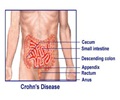Allura Red is a food coloring that is commonly found in candies, soft drinks, dairy products, and some cereals. This common food dye has been linked to inflammatory bowel disease.
- Allura Red is a commonly used food coloring. It offers color and texture and is frequently used to entice children
- Long-term consumption of this dye affects intestinal function, resulting in gut alterations that increase the risk of colitis
- These findings have significant implications for the prevention and management of gastrointestinal inflammation
How Food Dyes Affect your Gut
The dye directly impairs gut barrier function and promotes serotonin synthesis, a hormone/neurotransmitter found in the gut, altering gut microbiota composition and increasing vulnerability to colitis.What is Allura Red Food Dye
Allura Red (also known as FD&C Red 40 and Food Red 17) is a frequent ingredient in candies, soft drinks, dairy goods, and some cereals, according to Khan. The dye is commonly used to give color and texture to dishes to attract youngsters.The usage of synthetic food dyes such as Allura Red has expanded dramatically over the last several decades, yet there has been little prior research on the impact of these colours on gut health. Khan and his colleagues reported their findings in the journal Nature Communications. The first author is Yun Han (Eric) Kwon, who recently earned his Ph.D. in Khan’s laboratory.
Harmful Effects of Allura Red Food Dye
“This study demonstrates significant harmful effects of Allura Red on gut health and identifies gut serotonin as a critical factor mediating these effects. These findings have important implications in the prevention and management of gut inflammation,” said Khan, the study’s senior author, a professor of the Department of Pathology and Molecular Medicine and a principal investigator of Farncombe Family Digestive Health Research Institute.Food Dye’s Trigger Inflammatory Bowel Disease (IBD)
“What we have found is striking and alarming, as this common synthetic food dye is a possible dietary trigger for IBDs. This research is a significant advance in alerting the public on the potential harms of food dyes that we consume daily,” he said. “The literature suggests that the consumption of Allura Red also affects certain allergies, immune disorders and behavioural problems in children, such as attention deficit hyperactivity disorder.”What is Inflammatory Bowel Disease
IBDs are significant chronic inflammatory disorders of the human gut that impact millions of people globally, according to Han. While the specific reasons are unknown, research has revealed that these disorders can be triggered by dysregulated immunological responses, genetic factors, gut microbiome abnormalities, and environmental factors.Significant progress has been made in identifying susceptibility genes and understanding the involvement of the immune system and host microbiota in the pathogenesis of IBDs in recent years. However, he claims that similar breakthroughs in pinpointing environmental risk factors have lagged.
Environmental Factors for Inflammatory Bowel Disease
Environmental factors for IBDs, according to Khan, include the usual Western diet, which contains processed fats, red and processed meats, sweets, and a lack of fibre. He went on to say that the Western diet and processed foods contain a lot of different additives and colours.He went on to say that the findings reveal a link between a commonly used food colour and IBDs and that greater research into food dyes and IBDs is needed at the experimental, epidemiological, and clinical levels.
Source-Medindia
















